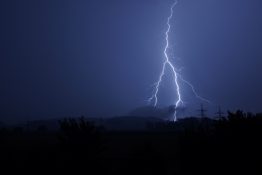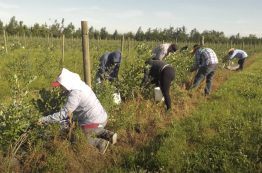Lightning is one of the most destructive forces of nature, as in 2020 when it sparked the massive California Lightning Complex fires, but it remains hard to predict. A new study led by the University of Washington shows that machine learning — computer algorithms that improve themselves without direct programming by humans — can be used to improve lightning forecasts. Better lightning forecasts could help to prepare for potential wildfires, improve safety warnings for lightning and create more accurate long-range climate models.
Read more at UW News »Kat Huybers
Read more »
Deforestation, climate change linked to more worker deaths and unsafe conditions
Outdoor workers in the world’s lower-latitude tropical forests may face a greater risk of heat-related deaths and unsafe working conditions because of deforestation and climate warming, according to a study led by The Nature Conservancy, the University of Washington and Indonesia’s Mulawarman University. In the study, researchers found that increased temperatures of 0.95 C (1.7 F) in the deforested areas of Berau Regency, Indonesia, between 2002 and 2018 were linked to roughly 118 additional deaths in 2018, and 20 additional minutes of daily conditions too hot for humans to work in safely.
Read more at UW News »New method shows today’s warming ‘unprecedented’ over past 24,000 years
A new effort to reconstruct Earth’s climate since the last ice age, about 24,000 years ago, highlights the main drivers of climate change, and how far out of bounds human activity has pushed the climate system. The University of Arizona-led study uses a technique for reconstructing past temperatures developed by co-authors at the University of Washington. The study, published Nov. 10 in Nature, has three main findings: It verifies that the main drivers of climate change since the last ice age are rising greenhouse gas concentrations and the retreat of the ice sheets It suggests a general warming trend over the last 10,000 years — settling a decade-long debate in the paleoclimatology community about whether this period trended warmer or cooler The magnitude and rate of warming over the last 150 years far surpasses the magnitude and rate of changes at any other time over the last 24,000 years “Paleoclimate records provide the only record we have of these past climates, but these records are imperfect and they have gaps in space and time.
Read more at UW News »UW professor and lead author on IPCC report sees hope for our climate future
It may seem counterintuitive, but on the heels of the most recent IPCC report on our changing climate, Kyle Armour finds reasons for optimism. “The degree of climate change we’ll experience this century depends on our future greenhouse gas emissions, which depend on the collective choices we make. Our future is up to us,” says Armour. He posted his thoughts on Twitter when many headlines about the report’s findings were overwhelmingly grave.
Read more »




